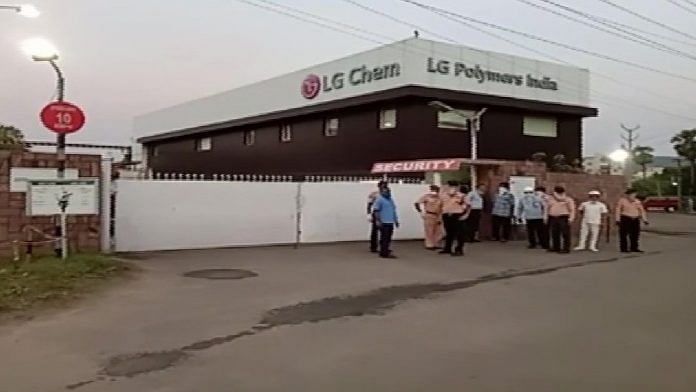New Delhi: A chemical leak from the LG Polymers plant in Visakhapatnam early Thursday morning killed at least seven people and triggered panic in the industrial coastal city.
According to preliminary reports, authorities said, the chemical that caused the deaths, and also illness in many others exposed to it, was styrene.
ThePrint explains the what the substance is and how it may affect human beings.
What is styrene?
Styrene is a colourless, sweet smelling liquid that serves as a key ingredient for plastics and polymers.
The compound is widely used to make plastics and rubber. Consumer products like packaging materials, insulation for wiring and appliances, fibreglass, plastic pipes, automobile parts and drinking cups contain styrene.
Exposure to styrene
Low levels of chronic exposure to styrene may be carcinogenic.
According to the United States Environmental Protection Agency (EPA), short-term exposure to low levels of styrene in humans can cause irritation in the mucous membrane and eye, and gastrointestinal effects.
Long-term exposure, on the other hand, results in effects on the central nervous system, leading to headaches, fatigue, weakness, hearing loss, nerve damage and depression.
According to the Health and Safety Executive, a UK government agency responsible for regulation and enforcement of workplace health, safety and welfare, the chemical can cause loss of consciousness and death at high exposure levels.
Also read: Why methane is a far more dangerous greenhouse gas than carbon dioxide
How did the styrene leak?
According to Parameswar Iyer, from the Department of Chemistry, IIT Guwahati, styrene, which is itself toxic, can’t spread to a radius of 4-5 kilometres on its own. “It seems more likely that some other chemical may have also leaked, together with styrene,” he told ThePrint.
“But if high levels of styrene vapour is inhaled, it causes skin and eye irritation, and breathing difficulties,” he added.
Dr. Swaminathan Sivaram, former director of the National Chemical Laboratory, Pune, also said more details need to be known to ascertain what led to the leak.
“If it is leaking in the air, it must be a gaseous material, not a liquid material. Styrene is a liquid with a high boiling point,” Sivaram told ThePrint.
“Unless there are high temperature conditions — such as a fire or an explosion — styrene can not leak into the air,” he said.
The chemicals in the factory had been unattended since March due to the Covid-19 lockdown.
“We need to understand a little bit more about what was happening at the time that this incident happened,” Sivaram said.
Also read: 35 years after Bhopal gas tragedy, coronavirus kills 10 survivors who had comorbidities




At the time of the Bhopal Incident, there was no social media . The Print Media, both English and Vernacular, were more serious in reporting tragedies, barring some stray cases of biased reporting to tilt towards desired Political impact. But the VIZAG Incident,with far less human impact, has been blown out of proportion by thew social media.The comic truth is that every other person has become an expert on Chemical Engineering and is ready to pontificate on it.. At least the Principal Media houses should restrain this trend and promote cool headed reflection in the matter and come with positive suggestions. Had the Lock down 1.0 been announced with a clear margin of at least half a day, the Factory management would have had breathing time to shut down the systems following the SOP fully. It will need to be looked into whether this hurry had also played a role in the eventual mishap.
I doubt that the cause of the Vizag tragedy was styrene gas leak. Most probably it is a planted idea to save the responsible company in future when the case will go to the court. My assumptions are based on the following facts.
1. People were falling unconscious without smelling any odour while the normal human nose can smell this gas at 50ppm level in the air but none of the reports said that it was smelled by anyone. The gas causes even mild toxicity on long term exposure of >300ppm in air. To cause such severe toxicity that is death on exposure the gas concentration is required to be 10000 ppm, and at 60 degrees C even under saturation level gas can reach only about 8000 ppm (that is in the closed chamber). That lethal concentration is almost impossible to reach in an open-air environment.
2. Styrene is neither gas nor volatile because its boiling temperature is 145 degrees centigrade. The styrene gives out irritating or toxic fumes (or gases) in a fire only. It is reported as a gas leak, not fire blast, that means it was not the cause.
3. Styrene is 3.6 times heavier than air and rapidly settle down, not spread at height more than 3 ft, but in nearby village and area, people fell which walking, animals died when standing.
4. As you can smell styrene as irritating toxic fumes and get suffocated you will struggle before you succumb to the styrene poisoning but in none of the cases shown on TV or in media, any struggle was evident even in animals.
This all shreds of evidence create doubt about the investigation and the case is made weak to be fought in the Court.
Everything is possible to save rich and mighty in India.